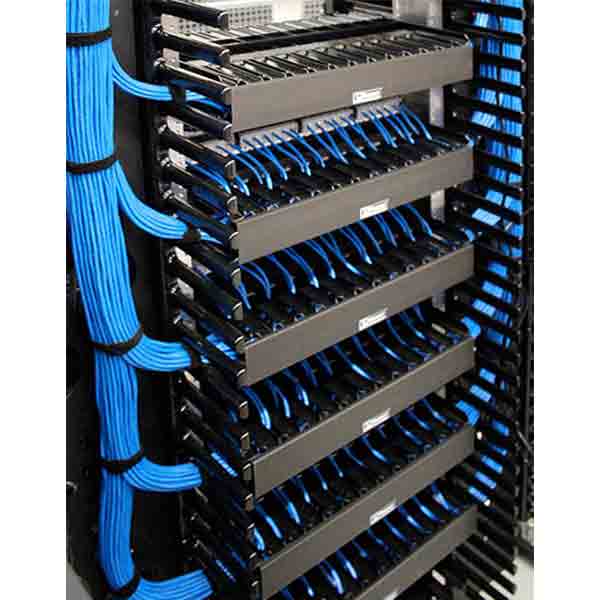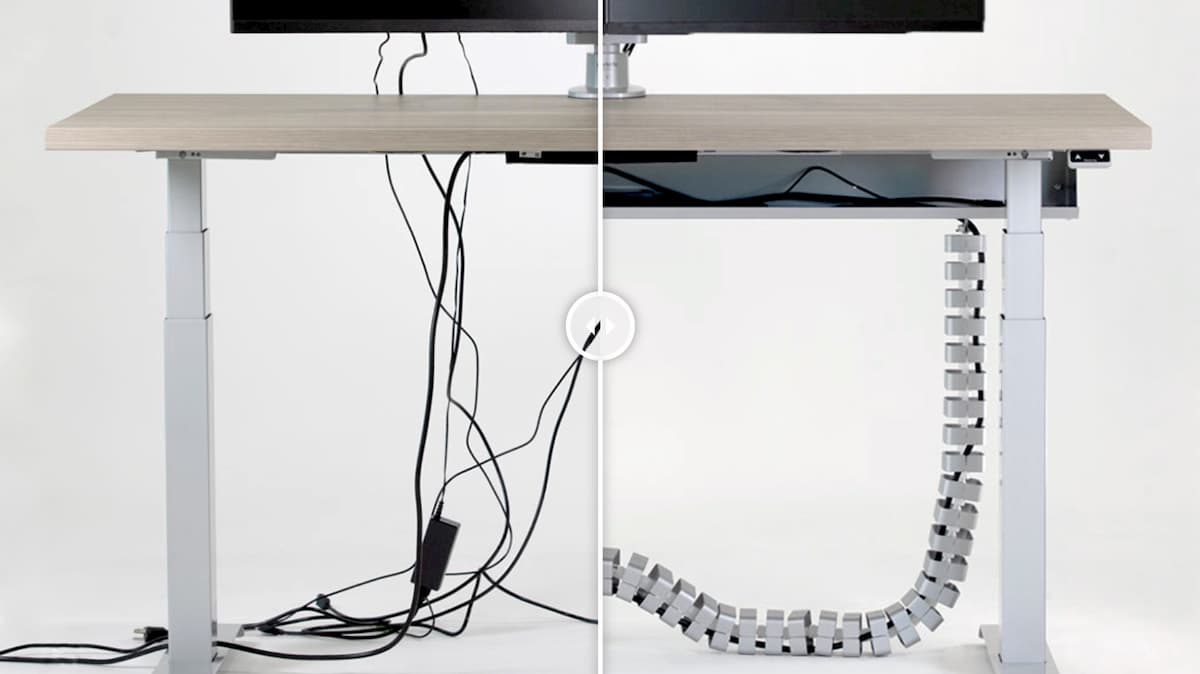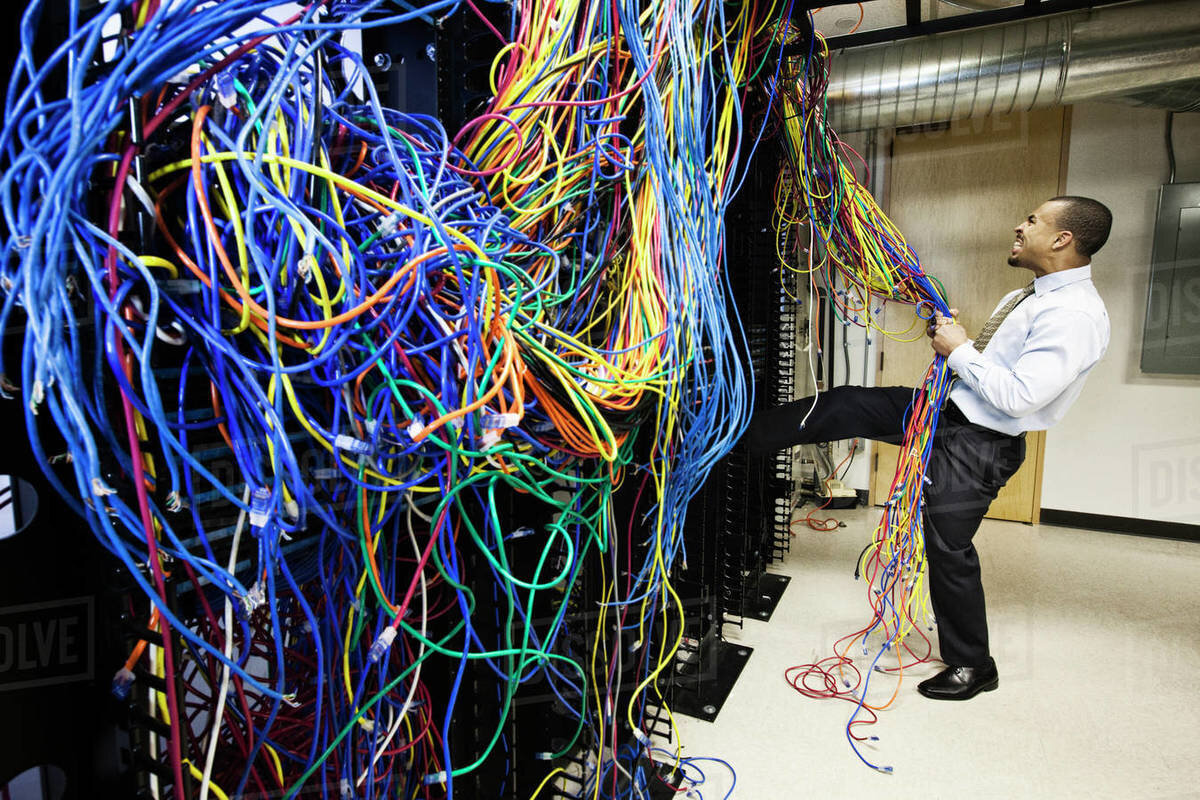Cable management is the process of organizing and securing cables to ensure a clean, efficient workspace. It helps prevent tangling and damage.
Effective cable management is crucial for both home and office environments. Properly organizing cables reduces clutter, enhances safety, and improves the overall aesthetics of a space. It also makes troubleshooting and maintenance easier, saving time and effort. Cable management solutions include cable trays, ties, and sleeves, which keep wires neatly arranged.
This practice is essential in data centers, where a large number of cables are used. A well-organized system prevents overheating and equipment failure. By implementing good cable management practices, you can create a more efficient and visually appealing environment.

Credit: infinity-cable-products.com
The Tangled Challenge
Cable management is the art of organizing cables. It ensures a clean and safe space. Many people face the tangled challenge. This happens when cables become a mess. It looks bad and can cause problems.
Why Cables Get Out Of Hand
Cables often get out of hand due to many reasons. Here are some common causes:
- Overuse of devices: More devices mean more cables.
- Improper storage: Cables are not stored properly.
- Lack of planning: No thought given to cable layout.
- Frequent changes: Often changing or adding new cables.
The Impact Of Cluttered Cables
Cluttered cables can cause many problems. Here are some impacts:
- Safety hazards: Tripping over cables can cause injury.
- Device damage: Tangled cables can break or wear out.
- Reduced efficiency: Hard to find the right cable when needed.
- Unpleasant appearance: Messy cables make the area look bad.
Proper cable management solves these issues. It makes spaces safer and more efficient. Organize your cables to avoid the tangled challenge.
Unraveling Cable Management
Cable management involves organizing cables to ensure safety and efficiency. Properly managed cables prevent accidents and improve device performance. This blog post dives into the essentials of cable management.
Defining Cable Management
Cable management means organizing cables to avoid clutter and confusion. This involves labeling, bundling, and routing cables neatly. It also includes using tools like cable ties, clips, and organizers.
Here are some common tools used in cable management:
- Cable Ties: Used to bundle cables together.
- Cable Clips: Secure cables to surfaces.
- Cable Organizers: Keep cables sorted and accessible.
The Importance For Safety And Efficiency
Good cable management is crucial for safety and efficiency. Tangled cables can cause trips and falls. They can also damage devices and reduce performance.
Here are key benefits of proper cable management:
- Safety: Reduces trip hazards and fire risks.
- Efficiency: Enhances device performance and longevity.
- Accessibility: Makes it easier to troubleshoot and replace cables.
Proper cable management also improves aesthetics. A tidy workspace boosts productivity and morale.
Consider the following table for a quick overview of cable management benefits:
| Aspect | Benefit |
|---|---|
| Safety | Prevents accidents and fire hazards |
| Efficiency | Improves device performance |
| Accessibility | Makes troubleshooting easier |
| Aesthetics | Creates a neat workspace |
Proper cable management is essential in homes and workplaces. It ensures safety, efficiency, and a clean environment.
Starting With A Plan
Good cable management begins with a solid plan. Without one, your cables can get tangled. This can lead to a mess and even damage. A proper plan helps you stay organized. It also saves you time and effort.
Assessing Your Cable Situation
First, you need to know what cables you have. Look around your workspace. Identify all the cables and cords. Make a list of each one. Note the type, length, and purpose. This helps you see what you need to manage.
Next, check the condition of your cables. Are they frayed or damaged? Replace any that are unsafe. Good cables make management easier and safer. Now, you have a clear picture of your cable situation.
Mapping Out Your Approach
Now that you know your cables, plan where they should go. Think about the best routes for each cable. This will help you avoid tangles and clutter. Draw a simple map if needed. This helps you visualize the layout.
Consider the length of each cable. Shorter cables might need extensions. Longer cables might need to be coiled. Use zip ties or Velcro straps for this. Properly routed cables are easier to manage and look cleaner.
Organizing Tools And Accessories
Having the right tools is crucial. Some common tools for cable management include:
- Zip ties
- Velcro straps
- Cable clips
- Cable sleeves
Use a cable management box for power strips. This keeps things tidy. Label your cables for easy identification. Colored labels or tags can help.
Documenting Your Setup
Keep a record of your cable setup. Take a photo or draw a diagram. This helps you remember where each cable goes. It also makes future adjustments easier. Documentation is a good habit for long-term management.
Store the documentation in a safe place. You can refer to it whenever needed. This way, your cable management stays effective.

Credit: workriteergo.com
Tools Of The Trade
Cable management keeps your cables neat and organized. Essential tools help achieve this. These tools simplify cable management tasks. Let’s explore some of these tools.
Cable Ties And Clips
Cable ties and clips are basic yet effective. They hold cables together. They prevent tangling and damage. They come in various sizes and types.
- Zip Ties: These are plastic and reusable. They are easy to use.
- Velcro Ties: These are soft and adjustable. They are ideal for temporary setups.
- Cable Clips: These attach to surfaces. They keep cables in place.
Cable Sleeves And Conduits
Cable sleeves and conduits protect and group cables. They provide a clean look. They also prevent wear and tear.
- Cable Sleeves: These are flexible tubes. They bundle multiple cables together.
- Cable Conduits: These are rigid or flexible tubes. They shield cables from damage.
Both types offer easy installation. They enhance safety and aesthetics.
Labels And Tags
Labels and tags identify cables easily. They are crucial for complex setups. They prevent confusion and save time.
- Adhesive Labels: These stick to cables. They are customizable and easy to read.
- Tag Markers: These attach to cables. They are durable and reusable.
Using these tools ensures organized and safe cable management.
Practical Cable Management Tips
Keeping cables neat is key for a clean workspace. It also ensures safety and efficiency. Here are some practical tips for managing your cables effectively.
Separating Power From Data Cables
Power cables and data cables should not mix. This prevents interference. Use different pathways for each type. This improves signal quality and reduces noise.
Using Vertical And Horizontal Spaces
Utilize both vertical and horizontal spaces. Use wall-mounted racks for vertical space. Place cable trays under desks for horizontal space. This keeps cables off the floor and out of sight.
| Vertical Space | Horizontal Space |
|---|---|
| Wall-mounted racks | Cable trays under desks |
| Cable hooks | Floor cable covers |
Regular Maintenance Routines
Regular checks keep cables in good shape. Inspect cables monthly. Look for wear and tear. Replace damaged cables immediately. This reduces risks and keeps your setup tidy.
- Monthly inspections
- Replace damaged cables
- Reorganize cables as needed
Wireless Solutions
Cable management can be tricky. Wireless solutions offer a neat alternative. They reduce clutter and improve aesthetics. This section explores wireless options.
When To Go Wireless
Not all devices need cables. Wireless options work well for many gadgets.
- Use wireless keyboards and mice for a clean desk.
- Wireless headphones give freedom of movement.
- Wi-Fi replaces Ethernet cables for internet.
- Bluetooth speakers remove the need for audio cables.
Pros And Cons Of Cutting The Cords
Going wireless has benefits and drawbacks. Consider these points:
| Pros | Cons |
|---|---|
| No cable clutter | Battery needs charging |
| More mobility | Possible interference |
| Easy setup | Sometimes less reliable |
| Modern look | Can be more costly |
Wireless solutions can simplify cable management. They offer a neat, modern look. Evaluate the pros and cons before making a switch.
Creative Organizing Hacks
Cable management can seem hard, but it does not have to be. With some creative hacks, you can easily manage your cables. This section shares some simple and smart ideas to keep your cables tidy.
Diy Solutions For Cable Management
DIY solutions are fun and often cost nothing. You can make your own cable organizers with things you already have.
- Toilet Paper Rolls: Use empty rolls to hold cables. Just label each roll for easy finding.
- Bread Clips: Attach bread clips to cables. Write the cable type on the clip.
- Binder Clips: Clip them to the edge of a desk. Run cables through the handles to keep them in place.
Repurposing Common Household Items
You can repurpose items you already have at home. This saves money and helps keep your space organized.
| Item | Usage |
|---|---|
| Old Shoebox | Cut holes in the sides. Use the box to store and organize cables. |
| Twist Ties | Use twist ties to bundle cables together. It keeps them neat. |
| Velcro Strips | Wrap velcro strips around cables. This keeps them from tangling. |
Professional Cable Management Systems
Professional cable management systems are crucial for businesses. They keep cables organized and safe. These systems prevent tangling and reduce fire risks. Proper cable management also improves the look of your workspace.
Investing In Robust Solutions
Investing in robust cable management solutions is smart. Quality systems last longer. They also protect your cables. Durable systems minimize downtime. This keeps your business running smoothly.
| Benefits | Details |
|---|---|
| Durability | Long-lasting materials |
| Safety | Reduces fire risks |
| Efficiency | Minimizes downtime |
| Appearance | Improves workspace look |
Case Studies Of Effective Systems
Let’s look at some case studies. These examples show effective cable management. They highlight the benefits of professional systems.
- Office Building A: They used cable trays and raceways. This reduced clutter and improved safety.
- Data Center B: They installed vertical and horizontal managers. This enhanced airflow and prevented overheating.
- Factory C: They implemented cable covers and conduits. This protected cables from damage and ensured compliance with safety standards.
Staying Organized
Staying organized with cable management helps keep your workspace tidy. This reduces stress and improves efficiency. It prevents cables from tangling and getting damaged. An organized setup can also be aesthetically pleasing.
Developing Good Habits
Developing good habits is key to effective cable management. Here are some tips:
- Label Your Cables: Use labels to identify each cable.
- Use Cable Ties: Bundle cables together with ties.
- Route Cables Properly: Keep cables out of the way.
- Keep Cables Short: Use the shortest cable needed.
Periodic Review And Reorganization
Periodic review and reorganization ensure your cables stay organized. This involves checking your setup regularly. Here is a simple table to guide you:
| Action | Frequency |
|---|---|
| Check for Damaged Cables | Monthly |
| Re-label Cables | Every 3 Months |
| Reorganize Cable Routes | Every 6 Months |
Follow these steps to keep your workspace neat. A neat workspace boosts productivity and safety.

Credit: infinity-cable-products.com
Frequently Asked Questions
What Is Meant By Cable Management?
Cable management refers to organizing and securing cables to reduce clutter and improve functionality. It enhances safety and aesthetics.
Why Is Cable Management So Important?
Cable management improves safety, enhances aesthetics, and boosts system performance. Proper organization prevents overheating and reduces tripping hazards. Neat cables facilitate easier maintenance and upgrades.
What Is Cable Management In Safety?
Cable management in safety involves organizing and securing cables to prevent tripping hazards, equipment damage, and fire risks. It ensures a tidy workspace, reduces accidents, and enhances efficiency. Proper cable management includes using clips, sleeves, or trays to keep cables off the floor and out of harm’s way.
What Is Data Cable Management?
Data cable management organizes and secures cables in a clean, efficient manner. It improves system performance, accessibility, and safety. Effective management reduces clutter, prevents damage, and enhances maintenance. Properly managed cables support better airflow and cooling. It is crucial for both home and business IT environments.
Conclusion
Cable management is essential for a tidy workspace. It improves efficiency and reduces clutter. Proper organization ensures safety and extends the life of your equipment. Investing time in cable management now saves headaches later. Keep your setup clean and efficient for a more productive environment.




